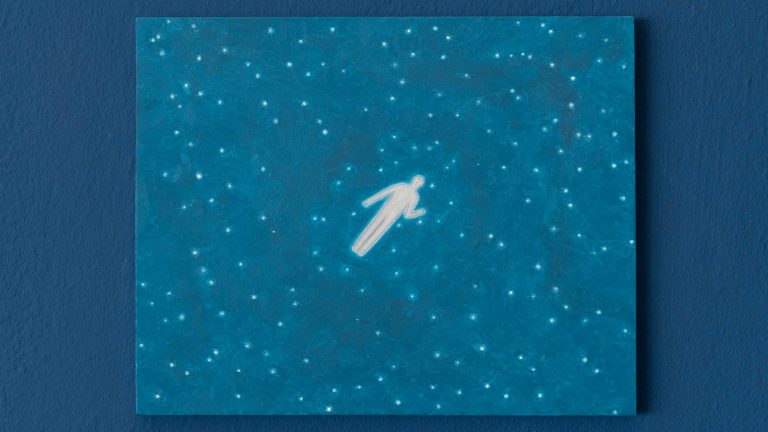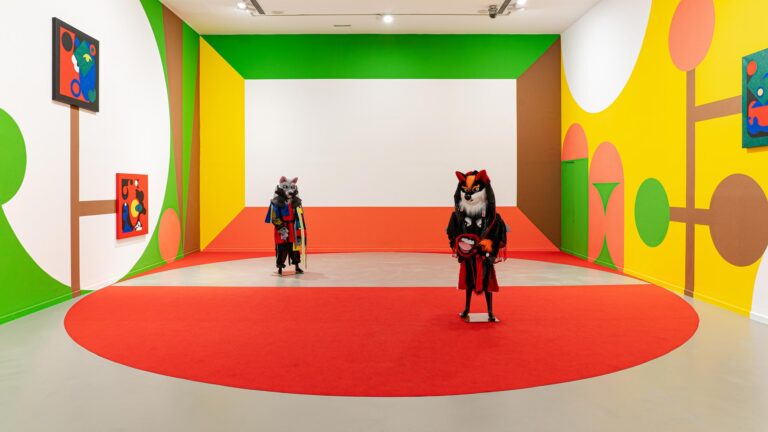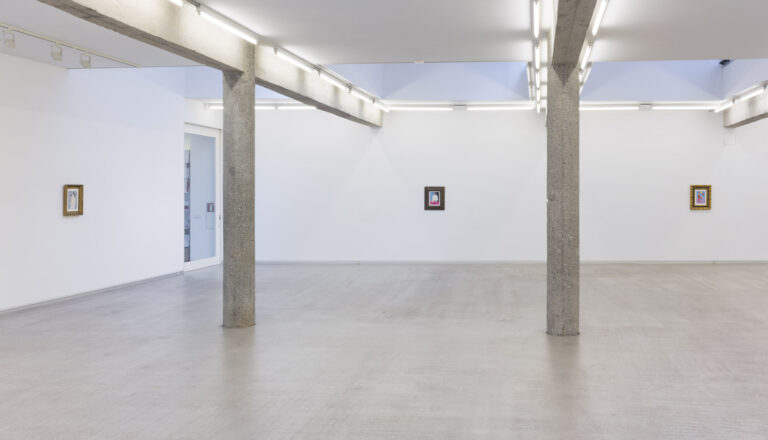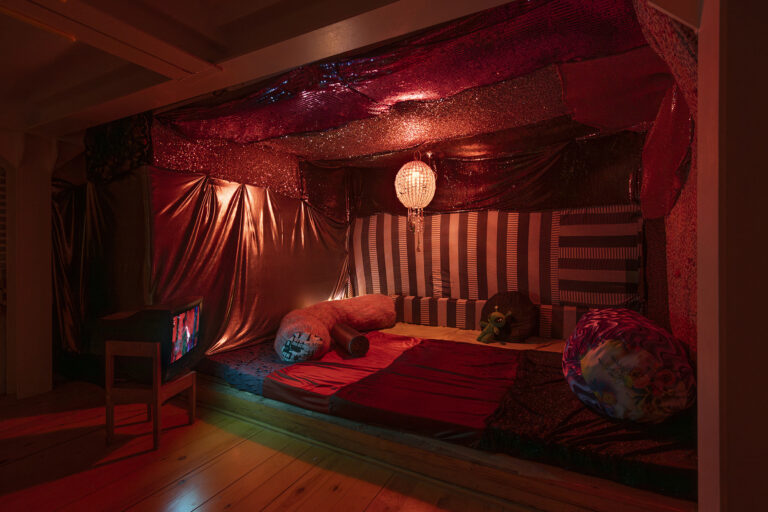Artists: Anna Daucíková and Zbynek Baladrán
Exhibition title: Circular Defense
Curated by: Beatriz Herráez
Venue: CarrerasMugica, Bilbao, Spain
Date: May 17 – July 27, 2018
Photography: Daniel Mera / all images copyright and courtesy of the artists and CarrerasMugica, Bilbao
This exhibition came about from an invitation issued by Galería CarrerasMugica and brings together works (in video, photography, sculpture and text) by Anna Daučíková (Bratislava, 1950) and Zbyněk Baladrán(Prague, 1973)[1]. Given the title Circular Defense,[2] and taking as its starting point 1989 (a year marked by, among other events, the fall of the Berlin Wall) the works on show deploy a series of images that intersect and overlap to construct a polyphonic narrative against a backdrop of the socio-political transformations in Eastern Europe and their effects.
The exhibition opens with a series of photographic works produced by Anna Daučíková during the years when she lived and worked in Moscow, the city she moved to in the late seventies and where she remained until 1991. The series
Moscow, Women, Sunday and Celebration reflect the sense of exhaustion and collapse of the Soviet system through images portraying scenes and situations of extreme poverty in which many women lived in the context of so- called real socialism. Almost as if it were showing the dismal double of the figure of the Stakhanovite, Daučíková’s images document these women wandering the streets every Sunday, contrasting with the practically complete absence of men in the same spaces: “Their unrelenting energy, as well as the survival mechanisms that enabled them to combine their jobs as well housework, 24 hours a day, 7 days a week, became the leitmotiv of this series of portraits and a tribute to women as a representation of the disappearance of a style of life and an historical era on the point of vanishing.”[3] It creates a counter-image of the regime’s glorification of work and physical labour, in which the sole presence of these bodies represents the evident failure of socialist pretensions to construct a superior productive man. Far from remaining in a past already assigned to official History from a Western ideological perspective, these images are subtended by a capacity to forge unexpected connections in relation to the habits of the collective.
1989 was also the year when the Czech communist newspaper Rudé Právo folded, coinciding with the appearance of the liberal post-revolutionary daily newspaper Lidové noviny. The two publications are the documentary sources for Contingent Propositions (2015), Zbyněk Baladrán’s collage that expands over 70 metres on the gallery walls, confronting the historical consequences of late capitalism in the Czech Republic and the current moment: “Taking these two local Czech newspapers as my source I map the legacy of the ideological monsters of the twentieth century, summarising the coordinates of a global future still in the making. Recycling documents from the past provides clues
that lead to the Great Recession of 2008 and is perhaps a reflection of the new form of the post-capitalist world.”
This thesis and hypotheses on what happened and is happening is further contribute the narratives proposed by the characters in Three Curtains (2014), a film in which Daučíková addresses, from an autobiographical perspective, the spaces of enclosure and non-communication that characterized the regime of the former USSR through different cases studies that document the progressive closing of boundaries. To this end, the artist focuses on three historical moments —1920s, 50s and 80s— through the experiences of different lives affected by the country’s strict regulation with regards the outside world.
Following this “testimonial” methodology, in On Allomorphing (2017) Daučíková explores what she calls “the mental body” as a space of negotiation, examining different forms of learning and construction of political subjectivity. Once again, they are the lives of various individuals that build a weave or network of statements which includes the voices of a transgender activist and a woman who speaks about Valery Lamakh (1925–1978), a Ukrainian painter who traveling in the sixties from Kiev to the Lenin Library in Moscow after being told that, fifty years earlieranother artist called Piet Mondrian had already done the formal research he was developing. In one of the stories one can also hear the artist while she manipulates various objects built with glass: “When I was eight years old, I thought that if I lied down every night in a certain way that my body would grow as if it were inside a cast. I believed that with time that my body would recognise it and adopt the form I wanted. I dreamt of having a strong and chiselled body.”
As Simone Weil declared in her posthumous text “What is Sacred in Every Human Being?”, in which she attacks the ways in which twentieth-century political thinking erroneously understood the relationship between the individual and the collective, especially with regards Western democracies; “the biggest danger is not the tendency of the collective to compress the individual, but the tendency of the individual to throw himself into, to be swallowed up in the collective.” Shot in a former military base, To Be Framed (2017), one of Zbyněk Baladrán’s most recent films, also poses a reflection on these invisible boundaries that shape our bodies without allowing us to “speak or organize our lives”.
The film, accompanied by a voice over, pays attention to invisible forms of violence that propagate and order our relationships through a group of children playing in front of the camera.
Many of Baladrán’s works are underpinned by a reflection on the construction of alternatives following the disillusionment in the wake of the collapse of the grand narratives of the twentieth century. Taking specific forms that speak of systems and diagrams, there are many associations and hypotheses in his works that share features with the structures of the science fiction genre. In the work Automated Subject (2016), a suspended sculpture in which Baladrán uses his own texts and texts loosely based on writings of Stanislav Lem and Andrei Platonov to question the processes of construction of subjectivity: “Taking the idea of the automatic/automatism to the place of individual conscience facilitates including absolutely everyone in those privileged places that end up forging an idea of the universal, in which ‘all of us’ are included.”
[1] From the beginning this project sought to strike up a dialogue with practices that, while not belonging to the same context, did respond to ways of doing that appeared “close”. Thus, after several conversations held initially with Zbyněk Baladrán, an artist who has exhibited his works previously in the Basque Country, we decided to extend the invitation to Anna Daučíková.
[2] Kruhova Obrana (Circular Defense) is the title of a a book ofessays published by the historian Milan Šimečka (1930-1990) in 1984, which describes the contradictions of the experience of real socialism during so called “Normalisation” in 70` and 80` in Czechoslovakia.
[3] Texts in inverted commas are quotes from the artists.
Anna Daucíková and Zbynek Baladrán, Circular Defense, 2018, exhibition view, CarrerasMugica, Bilbao
Anna Daucíková and Zbynek Baladrán, Circular Defense, 2018, exhibition view, CarrerasMugica, Bilbao
Zbyněk Baladrán To be framed, 2016. Video 8’11”
Zbyněk Baladrán To be framed, 2016. Video 8’11”
Zbyněk Baladrán To be framed, 2016. Video 8’11”
Anna Daucíková and Zbynek Baladrán, Circular Defense, 2018, exhibition view, CarrerasMugica, Bilbao
Anna Daučíková Three curtains, 2014. Video 12′
Anna Daučíková Three curtains, 2014. Video 12′
Anna Daučíková Three curtains, 2014. Video 12′
Anna Daucíková and Zbynek Baladrán, Circular Defense, 2018, exhibition view, CarrerasMugica, Bilbao
Anna Daučíková Moscow / Women / Sunday, 1989-1990. 24 bw photographies (48 x 30 cm each)
Anna Daučíková Moscow / Women / Sunday, 1989-1990. 24 bw photographies (48 x 30 cm each)
Anna Daučíková Moscow / Women / Sunday, 1989-1990. 24 bw photographies (48 x 30 cm each)
Anna Daučíková Moscow / Women / Sunday, 1989-1990. 24 bw photographies (48 x 30 cm each)
Anna Daučíková Celebration I (above) and Celebration II (below), 1989. 3 bw photographies (21,5 x 30,5 cm each)
Zbyněk Baladrán Automated Subject-Entities that want to become other entities, 2016-2018. White print on paper. 1200 x 900 cm
Zbyněk Baladrán Automated Subject-Entities that want to become other entities, 2016-2018. White print on paper. 1200 x 900 cm
Zbyněk Baladrán Automated Subject-Entities that want to become other entities, 2016-2018. White print on paper. 1200 x 900 cm
Anna Daucíková and Zbynek Baladrán, Circular Defense, 2018, exhibition view, CarrerasMugica, Bilbao
Anna Daucíková and Zbynek Baladrán, Circular Defense, 2018, exhibition view, CarrerasMugica, Bilbao
Zbyněk Baladrán Contingent propositions (big version), 2015-2018. 283 digital collages. 25 x 7075cm
Zbyněk Baladrán Contingent propositions (big version), 2015-2018. 283 digital collages. 25 x 7075cm
Zbyněk Baladrán Contingent propositions (big version), 2015-2018. 283 digital collages. 25 x 7075cm
Zbyněk Baladrán Contingent propositions (big version), 2015-2018. 283 digital collages. 25 x 7075cm
Zbyněk Baladrán Contingent propositions (big version), 2015-2018. 283 digital collages. 25 x 7075cm
Zbyněk Baladrán Contingent propositions (big version), 2015-2018. 283 digital collages. 25 x 7075cm
Anna Daucíková and Zbynek Baladrán, Circular Defense, 2018, exhibition view, CarrerasMugica, Bilbao
Zbyněk Baladrán From the New Theological Jokes, 2017. PV print, 5pc, 42 x 35 cm each
Anna Daucíková and Zbynek Baladrán, Circular Defense, 2018, exhibition view, CarrerasMugica, Bilbao
Anna Daučíková On allomorphing, 2017. Video 16′
Anna Daučíková On allomorphing, 2017. Video 16′
Anna Daučíková On allomorphing, 2017. Video 16′
Anna Daučíková On allomorphing, 2017. Video 16′









































